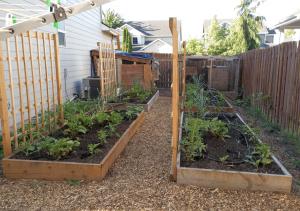
Researchers: It's Safe to Garden with Raised Beds Built with Preserved Wood
Study confirms using preserved wood for garden boxes has no impact on plants and produce
The researchers conducted the study in response to concerns raised on gardening forums and other Internet sites cautioning that the preservatives used in preserved wood could move out of the wood and contaminate the plants growing in raised beds, making the produce unsafe to eat.
The study compared plants and vegetables grown in garden boxes made from preservative-treated and untreated wood. Vegetables, herbs and plants from two growing seasons in both box types were analyzed.
“Our results confirm that those concerns are unwarranted,” said Gerald Presley, Ph D., an assistant professor at OSU and lead researcher in the project. “Copper levels measured in the plants were indistinguishable regardless of whether the beds they came from were built with preserved wood or untreated wood. Thus, the produce from preservative treated beds did not accumulate excess chemical from the pressure treated wood contrary to many online claims.”
Presley said copper is a micronutrient that plants need for growth and development, so it was not surprising to find that all the plants in the study contained some copper.
“The key point,” he said, “is that the copper levels were indistinguishable across bed types, so it’s clear that the material used to build the beds has no impact on the plants or vegetables.”
The majority of preserved wood available in retail locations today is treated with preservatives containing copper and other biocides. Copper azole (CA-C) is the predominant preservative used in the western U.S. The active ingredients in the preservative are used in hundreds of other everyday products including cleaners, disinfectants and medications.
The study sought to answer two questions regarding raised beds built with wood preserved using copper azole: 1) Does copper from preserved wood used in garden boxes migrate into the soil? and 2) If the copper does move, do the fruits, vegetables and herbs grown in the raised beds absorb the copper?
After studying those questions over two growing seasons, the researchers reported only a minor amount of copper migrated from the wood into the soil and slightly higher levels of copper were found mostly in the soil immediately adjacent to the preserved wood. Of greater interest to home gardeners, the researchers concluded conclusively the use of preserved wood to build garden boxes does not impact metal levels in food crops.
While the choice of material clearly doesn’t affect the produce, it does impact how long the beds will remain serviceable. Wood garden beds are subjected to insects such as termites and decay-causing fungi, which over time can degrade the wood fiber.
In some climates, the time it takes for wood degradation to occur can be quite short. One of the untreated beds in the OSU study began showing significant signs of decay within the first year of the two-year study. Preserved wood, on the other hand, typically carries a warranty against decay of 25 years or more. The preserved wood in the study garden boxes showed no signs of deterioration after two years.
Details about the study and its findings can be found in a new Western Wood Preservers Institute (WWPI) publication PreserveTech: Safe Garden Boxes Using Preserved Wood, available online at https://wwpi.info/PT-GardenBoxes.
A full summary of the study also is available from the OSU Extension Service at https://wwpi.info/OSUGardenBox.
About WWPI
WWPI represents preservative treated wood product manufacturers, preservative manufacturers and others serving the industry throughout western North America. For more than 75 years, WWPI has provided technical support and market outreach services aimed at supporting the use of preserved wood in outdoor applications. See more at PreservedWood.org.
Photos and captions from the study are available on request.
Timm Locke
Western Wood Preservers Institute
+1 503-806-4831
timm@wwpi.org
EIN Presswire does not exercise editorial control over third-party content provided, uploaded, published, or distributed by users of EIN Presswire. We are a distributor, not a publisher, of 3rd party content. Such content may contain the views, opinions, statements, offers, and other material of the respective users, suppliers, participants, or authors.


